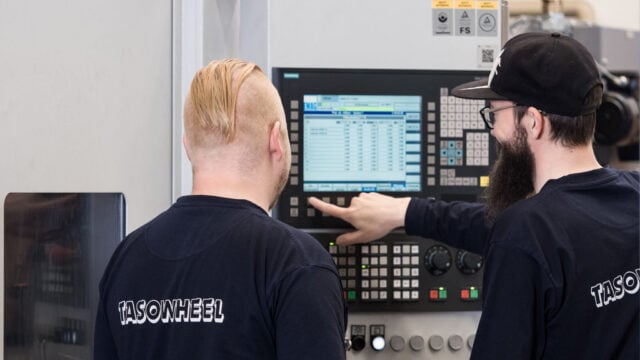
Bringing Transparency and Situational Awareness to The Shopfloor – Factory Cockpit at Tasowheel
Tasowheel is a Finnish family-owned contract manufacturer founded in 1979. The company has established itself as…

Part manufacturing is a complex process that involves a lot of moving parts, people, and equipment. Thus, oftentimes it is difficult to be on top of all the changing elements of a production process in the shop floor. “How to start monitoring and improving production efficiency and resource utilization?” is a common question among the industry. Little do people know, though, the answer lies just within their existing resources, IT systems and capabilities: the data. In other words, one of the keys to success in this industry is being able to lead and develop manufacturing with data, and in this blog post we are exploring the drivers behind this movement and how to get started.
Part manufacturing is a crucial aspect of many industries, from aerospace to machine building, fluid technologies (pumps, valves, compressors) and medical. The availability, quality and consistency of the parts being produced can have a significant impact on the performance and reliability of the final products. Therefore, it is essential to ensure that the manufacturing process is as efficient and effective as possible. To achieve this, using data to gain insights into the manufacturing process is one viable option. Data can be collected from a variety of sources, including shop floor devices, IT systems, and even employee feedback and comments. By combining and analyzing this data, manufacturers can identify areas where improvements can be made and develop strategies to optimize production processes.
Why using manufacturing data?
One of the primary benefits of using data in manufacturing is that it enables real-time monitoring of production processes. Devices in the shop floors can collect data on various aspects of the manufacturing process, such as machine performance. This data can be used to monitor production processes in real-time, allowing for identifying and addressing issues as they arise. For example, if a machine is running at lower than optimal performance, operators or production managers can identify this quickly and take corrective actions to avoid downtime and reduce waste.
Another benefit of leveraging data in manufacturing is that it can be used to optimize production schedules and reduce waste. By analyzing data on production rates and equipment performance, manufacturers can identify opportunities to increase production utilization and avoid bottlenecks. For example, if a machine is running below capacity, production managers can adjust its operation schedules to enhance efficiency and minimize downtime or wasted potential. In addition, information gathered from shop floor devices and IT systems can also be used for calculating production KPIs such as Overall Equipment Efficiency (OEE) and utilization rate, or error metrics like mean time to repair (MTTR), and mean time between failures (MTBF). These calculations are essential for determining efficiency levels of a manufacturing process, from which production managers or maintenance managers of the factory can stay on top of their manufacturing performance.
Data can also be used to improve overall supply chain management and collaboration among stakeholders. By collecting data on inventory levels, production schedules, and customer demand, manufacturers can optimize their supply chain to reduce costs and improve delivery times. This can be particularly important in industries where demand for products can fluctuate rapidly, such as machine building or fluid technologies. In addition, the information flow between one user to another can be significantly improved when data is organized, sorted, and shared for different roles within the supply chain; think of how suppliers can timely inform about available/ missing materials, operators can stay on top of their daily task lists, production managers can optimize production with real-time machine statuses and activities. All of which will ultimately lead to higher manufacturing utilization and efficiency.
Common challenges with data utilization
To make the most of the data collected, manufacturers must have the right tools to analyze and interpret the data. One common challenge that manufacturers face when implementing data-driven processes is data silos. Data silos occur when data is stored in separate systems or databases that do not communicate with each other. This can make it difficult to analyze data and gain insights into the overall manufacturing process. To overcome this challenge, manufacturers must ensure that data is collected in a centralized location and that systems are integrated to enable the sharing of data between different departments.
Another challenge that manufacturers face when implementing data-driven processes is data security. With the increasing amount of data being collected, it is essential to ensure that sensitive data is protected from unauthorized access. This can be achieved through purpose built systems utilizing proper encryption, firewalls, and access controls.
How to start?
In the part manufacturing industry, leading with data means leveraging the vast amount of data available from various sources such as machines, sensors, and production IT systems. The first step to leading manufacturing with data is to establish a data-driven culture within the organization. This involves investing in data collection, storage, and analysis tools and training employees to use these tools effectively. The next step is to define key performance indicators (KPIs) for the manufacturing process and monitor these KPIs continuously. By analyzing the data generated by these KPIs, manufacturers can identify areas for improvement and take corrective actions quickly. This approach enables manufacturers to optimize their production processes and improve the quality of their products, resulting in increased customer satisfaction and business growth.
Another important aspect of leading manufacturing with data is the use of predictive analytics. Predictive analytics uses historical data and machine learning algorithms to forecast future events and trends. In the part manufacturing industry, predictive analytics can help manufacturers anticipate production issues, identify maintenance needs, and optimize production schedules. By using predictive analytics, manufacturers can reduce downtime, increase productivity, and reduce costs. Moreover, the use of predictive analytics can help manufacturers improve product quality and increase customer satisfaction by identifying potential quality issues before they occur.
In conclusion, leading manufacturing with data is crucial for the success of the part manufacturing industry. By collecting and analyzing data from shop floors and IT systems, manufacturers can identify areas where improvements can be made, optimize production processes, reduce waste, and improve efficiency. Overall, leading manufacturing with data requires a combination of technology, culture, and strategy to maximize the benefits of data-driven decision-making, and companies that are willing to take the leap are sure to be at the forefront of the industry. Are you one of them?
Be first to see all the updates from MTDCNC
Our newsletters frequency varies dependant on content
All the latest deals from the industry feature on our newsletters